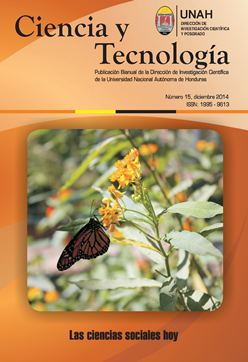Statistical analysis of the climatological database of relative humidity parameter Honduras
DOI:
https://doi.org/10.5377/rct.v0i15.2173Keywords:
relative humidity, historical series, statistical analysis, databaseAbstract
Honduras is a highly mountainous country, with a warm and humid weather, itseconomy is strongly based in agriculture and food production. The performance of this economic field could be influenced by different climatic factors such as Relative Humidity.
Relative humidity is a meteorological parameter which is measured in Honduras by 17% of the total of meteorological agencies. Unfortunately, there is no enough information as we would expect; moreover, most of the data that we do have is not 100% complete. Thus, if we want to work in a more efficient way, not only in agriculture, but also in the engineering field or the energy field, it is necessary to create a historical relative humidity database.
This research aim is to collect the most relative humidity data we can, so it can be studied and statistically analyzed. In this paper, we have acquired information from about 50 meteorological agencies. This data has been tested, completed and revised; making sure that we count with a continuous and homogeneous database. To complete the information provided by the different agencies, we have used a software that was developed in 2002 by the Spanish Cooperation Agency in Honduras. With the completion of this research, we can supply with a complete, homogeneous and reliable database in Honduras.
Revista Ciencia y Tecnología, N° 15, December 2014: 129-146
Downloads
1062
Downloads
Published
How to Cite
Issue
Section
License
© Revista Ciencia y Tecnología
Authors who publish in this journal accept the following conditions: In accordance with the legislation of copyright, Revista Ciencia y Tecnología, recognizes and respects the moral right of authors, as well as the ownership of the patrimonial right, which will be ceded to the magazine for its diffusion in open access in printed version and in digital format. By being part of multiple indexers, databases and reference systems, the articles published by Revista Ciencia y Tecnología will be visible and will be downloaded from these websites, indicating, in all cases, the authorship of the articles, the date of publication and the number of the journal to which they correspond.




